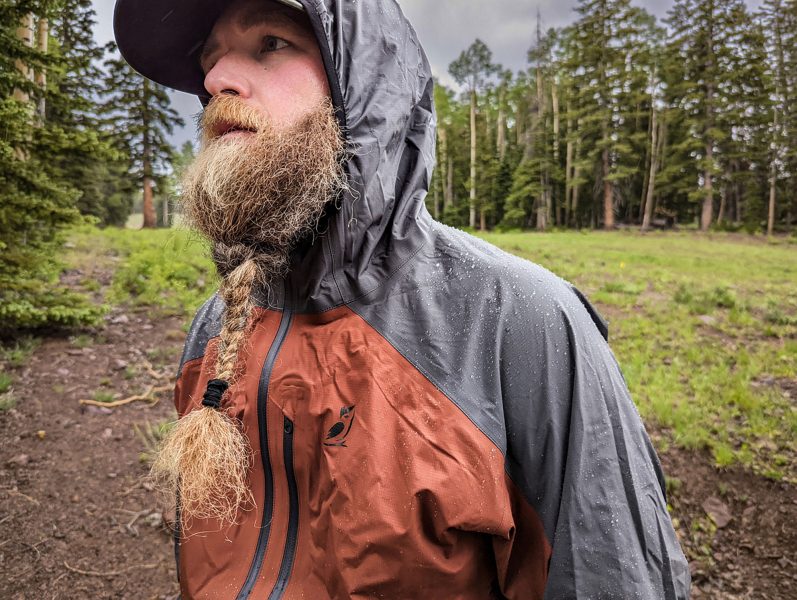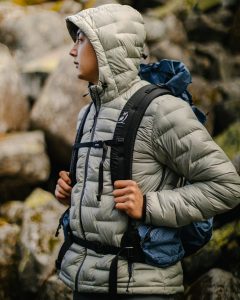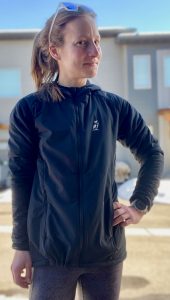
Image courtesy of Outdoor Vitals
Time on the trail is all about expecting the unexpected. Long hours on variable terrain means riding an inevitable rollercoaster of climates, landscapes, bodily sensations, emotional states, and more. It doesn’t matter what the forecast says or how seasoned you are. Mother Nature doesn’t care. Anything could happen out there. That’s the beauty of it.
The issue is, expecting the unexpected usually requires bringing along a lot of stuff. Baselayers, thermals, shells, shelters, gadgets, snacks; it all adds up fast. Such a full pack isn’t very conducive to moving fast and light through the wilderness.
The solution to shortening the laundry list? Gear that ticks multiple boxes at once … without half-assing any of them. So we’re getting Unpacked with Outdoor Vitals to see how this brand is taking a utilitarian approach for consolidation’s sake — even when that means going it alone.

The NovaPro Jacket (Image courtesy of Outdoor Vitals)
Tayson Whittaker, founder of Outdoor Vitals, doesn’t feel that the fastest way or the easiest way is how gear should be tested or delivered to outdoor enthusiasts. He prefers a slow burn. He knows that the highs aren’t always worth the lows. A brand built like a bonfire will fizzle out and collapse on itself just as quickly as it ignites. Whittaker wanted to invest in something steady enough to withstand ebbs, flows, and everything in between.
“We do business in a way that’s decidedly unsexy,” Whittaker said with a laugh. “But it’s worth it to play the long game by sticking to our roots.”
Direct to Consumer
For Outdoor Vitals, this translates to a direct-to-consumer business model. You won’t find these ultralight sleep systems, packs, or apparel items in any retail store.
“It’s much more difficult to go out and find customers and convince them to come to our website than it would be to retail in REI,” Whittaker admitted. “The problem with retail, though, is that the negatives dramatically outweigh the positives for a business like ours. We don’t want to design for price points and create products that fit into designated boxes. We want personal feedback from customers that we can take back into the field for future developments. We don’t want to subject customers to huge markups. The only way to do it our way is by taking out the middleman.”
This method puts all the work on the shoulders of Whittaker and his small in-house team. But “work” can look different when there’s no one else to answer to. The Outdoor Vitals crew hits the trail a minimum of once a week, on company time, for the sake of hands-on field testing.
“It’s an essential part of the design process,” Whittaker explained. “We’re not going to pursue technology just because it’s cheap, interesting, or innovative; it has to perform in the field.”
And without retail as part of the equation, he and his team can have the final say on what stays and what goes based on their own experiences. They prioritize time in the field so that there’s absolutely no guesswork involved.
Quality Before Cost
Whittaker opts out of catering to price points for the same reason. The number on the tag is the last thing that he thinks about when brainstorming a new product. It doesn’t matter how much a material costs if it doesn’t do the job right. Sometimes that means going with the more expensive option, like carbon fiber framing on one of their upcoming packs. But other times, the more economic material performs better than the one that comes at a premium, as in the case of their flagship Shadowlight Backpack.
“We tested Dyneema and other fabrics, and we just didn’t like them in the field even though they’re technically lighter and have that name recognition,” Whittaker explains. “So we went with Robic Nylon with Spectra Ripstop yarn woven into it. It turned out to be the cheaper choice, but that’s not why we chose it. It was just more effective. Materials depend on the specific product and our goals for that product. The price then lands where it lands.”

The Vario Jacket (Image courtesy of Outdoor Vitals)
This presents an interesting dilemma for the consumer. While we all talk a big game about hunting down the best deals, it’s easy to automatically judge pricier products as higher quality and cheaper ones as lesser than. Lower prices tend to make buyers label something as a “budget” product that will perform in kind.
“Most of the time, this is a correct assumption,” Whittaker admits. “One item usually has something special to it that gives it good reason to be more expensive. But that’s only when you’re comparing apples to apples in a retail environment. That just doesn’t apply to us in a different market.”
To that end, Whittaker puts considerable effort into his messaging around the relationship between price and quality. He shares the reasoning that goes into design choices as much as possible, so that the consumer can also learn to prioritize the why over the how much.
Affordability and Accessibility
That’s not to say that Whittaker doesn’t care about price. In fact, he cares deeply. He launched Outdoor Vitals as a fresh college grad who had had enough of always settling for the cheapest version of the gear he needed to get outside.
“Growing up in southern Utah, we used anything we could get our hands on to make it work: Walmart packs, second-hand shoes, trash bags, you name it,” he says. “My first piece of high-end gear changed my entire outdoor experience because I could focus on what I was doing instead of constantly worrying about whether my makeshift gear would be able to keep up with me.”
But the price on that kind of gear was often too high to justify — thanks in large part to the middleman. Whittaker removes that hurdle so he doesn’t have to hike up his prices on account of retail fees. He can cut costs where they don’t matter and keep them where they do, all while maintaining relative affordability.
Two Birds, One Stone
Let’s be honest, though: None of this really matters unless the gear is something to write home about. No amount of good intention can make up for poor design. Luckily, Whittaker really is up to something special here.
My closet consists of about 70 percent miscellaneous outer layers. Every time I try to pare it down, I hit a wall because each of them serves its own purpose. One’s for running fast in subfreezing temperatures but not warm enough for slower paces; this one’s nice and toasty for easy miles but has me dripping as soon as my heart rate spikes; another wicks away rain and snow like a boss but catches wind like a sail. You get the gist. Everything’s a little too specialized.
Not so with Outdoor Vitals. The best thing about these products is their versatility. And even when one item can’t cover all the bases, they’re each so lightweight and compact that space isn’t an issue.

The Vario Jacket (Image courtesy of Lucie Hanes)
The Vario Jacket does the best job of illustrating this. Think windbreaker meets micro-puff. This nine ounce layer keeps you warm when you need it most but ventilates generously as soon as you pick up the pace. It achieves this balance via 3DeFX Insulation, which acts like the springs under a trampoline. As you stretch the fabric with rapid movement, the coils expand to let body heat out and cool air in. But when you slow down and reduce your range of motion, the coils contract to trap in warmth. The Vario is my go-to on speedwork days that take me from a mellow jog to an agonizing sprint and back again in a matter of minutes. No more doubling back to retrieve all my discarded layers from the bushes!
The NovaPro addresses another issue: warm versus dry. Most jackets can’t do both (or at least not very well). Puffies tend to wilt when wet, and shells don’t offer much in the way of insulation. This jacket eliminates the weakest link of a traditional puffy: the stitch holes. Stitchless baffles do away with 10,000 points where moisture could otherwise seep in. And if any does, a small amount of synthetic insulation blended into the 850 fill down (RDS — Reliable Down Standard — certified, no less) keeps it lofted.
If you’re looking for a true rain jacket, the Tushar resolves the common conflict between light and durable. Outdoor Vitals was able to employ a new lamination technology from Toray that other companies rejected, deeming it too experimental to have any luck on a shelf. But Whittaker didn’t have to worry about fitting into a retail box. The durability for the weight was too good to pass up. The brand could pack two different membranes plus bonus features like pockets and pit zips all into a seven ounce package that holds up against the elements far better than its paper-thin exterior would suggest. Yeah, it’s an investment at $230. But so is getting a new jacket every time it rips on a tree branch.
It all circles back to performance. Gear performs better when it can bridge gaps because there are fewer opportunities for it to fail. Comfort in outdoor spaces grows from trust in your gear to ride out Mother Nature’s whims. For Whittaker, that’s the whole point: connecting people to the vital outdoors. Good gear is just a means to an end.
Unpacked is a regular feature on ActionHub to help people discover new performance and lifestyle items that will amplify their adventures and outdoor experiences. This article was not sponsored by the brand or any PR/marketing agency, and all opinions are that of the ActionHub writer.
Lucie Hanes is an avid writer and adventurer on rock and trail with a passion for sharing her outdoor enthusiasms through journalism and mental strength consultation.
 Your Privacy Choices
Your Privacy Choices
 The
The